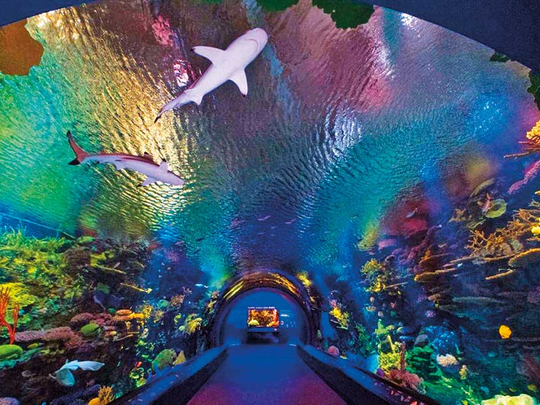
New York: “When you talk about wolves on Wall Street or bears on Broadway, you’re either talking about a metaphor or the distant past,” said Jon Forrest Dohlin, director of the New York Aquarium, while walking through the facility’s just-opened exhibit on sharks. As he spoke, the ancient marine predators glided through tanks all around him.
“Sharks aren’t somewhere else. They’re right here, in New York,” Dohlin continued. “It’s not in the middle of nowhere. It’s right here, in the middle of everything.”
In recent years, aquariums across the country have sought to connect visitors more closely to the marine wildlife that lives just off their shores. Now the Wildlife Conservation Society’s aquarium here, 60 per cent of which was destroyed during Hurricane Sandy in 2012, is connecting its ongoing research in the New York Bight to the experience its visitors have as they walk through a building just yards from the Atlantic Ocean.
The shark exhibit, which opened June 30 on Brooklyn’s Coney Island, opens with a tunnel overhead that showcases a colourful Indo-Pacific reef and the sort of sharks that thrive there — wobbegong, white-tips and black-tips. It also includes tanks that feature the bight, a 16,000-square-mile area from Cape May, New Jersey, to Montauk, New York. Roughly 20 million people live along that stretch, and as many as 25 species of sharks swim in those waters.
Hans Walters, one of the aquarium’s animal department supervisors and a field scientist with its New York Seascape Program, said researchers are working to gauge the extent to which the apex predators rely on the region as a nursery and feeding grounds. Over the past five years, he and colleagues have tagged about 40 animals as part of a habitat study of juvenile sand tiger sharks in the Great South Bay, and they have seen the same animals come back year after year.
Their fidelity to the region is “remarkable,” said Alisa Newton, head of aquatic health at the Wildlife Conservation Society’s Zoological Health Programme. The sharks migrate annually from northern Florida to as far north as the Bay of Fundy on Canada’s east coast, and they congregate in the New York Bight between June and September.
Sand tiger sharks come close to shore and have just one litter of one to two pups every other year, making them vulnerable to recreational fishing as well as other threats. Federal officials, along with those from states along the East Coast, enacted protections for the species in the late 1990s after researchers documented a decline in their numbers.
“They’re kind of running a gauntlet up and up and down the coast,” Walters said.
Sand tigers — which look fearsome but are less aggressive than many other shark species — are not the only sharks that use the New York Bight as a nursery. Great whites and makos rely on it as well. Newton said scientists have taken baseline blood samples and conducted a fatty acid analysis of several juvenile sharks to assess their prey and what sort of habitat they need to thrive. They hope to publish their findings this year, she said.
Inside the aquarium’s new 57,500-square-foot building — which features a dozen species of sharks, along with six species of skates and rays — visitors learn about the various shapes of the predators’ teeth (flat, pointy, curved and more) as well as how longline fishing, nets and demand for shark fins have contributed to their decline. WCS organised a letter-writing campaign that helped lead to the adoption of an ocean conservation plan for the mid-Atlantic region in 2016, and the aquarium provides screens where visitors can make conservation pledges once they have finished touring.
The aquarium’s 14-acre campus is still being rebuilt, and work won’t be complete until 2020; Dohlin still spends part of his time working in a trailer as the Cyclone roller coaster rattles overhead. The aquarium’s new features include a replica of the edge of the Hudson Canyon, the largest underwater canyon on the East Coast, along with a classroom overlooking the Atlantic where school groups can learn about acoustic tagging of whales nearby. Over the next two years, the facility plans to open exhibits focused on climate change and invertebrates.
In the meantime, Dohlin said, the exhibit aims to forge an emotional connection between visitors and marine wildlife.
“People will protect what they value,” he said.












